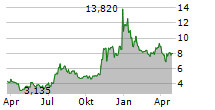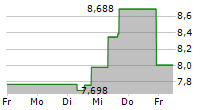
Part A of the placebo-controlled Phase 2 study has been completed
ANAVEX®3-71 demonstrates a dose-dependent pharmacodynamic effect on objective EEG biomarkers of schizophrenia
Patients are currently being dosed in Part B of the Phase 2 study which will investigate a longer treatment duration
NEW YORK, Oct. 17, 2024 (GLOBE NEWSWIRE) -- Anavex Life Sciences Corp. ("Anavex" or the "Company") (Nasdaq: AVXL), a clinical-stage biopharmaceutical company developing differentiated therapeutics for the treatment of Alzheimer's disease, Parkinson's disease, schizophrenia, neurodevelopmental, neurodegenerative, and rare diseases, including Rett syndrome, and other central nervous system (CNS) diseases, today announced encouraging preliminary electroencephalography (EEG) biomarker results from the Part A of the ongoing placebo-controlled Phase 2 clinical study of ANAVEX®3-71 for the treatment of schizophrenia.
Part A of the Phase 2 study ANAVEX®3-71-SZ-001 (NCT06245213), was a multiple ascending dose study in 16 participants treated with either oral placebo, oral ANAVEX®3-71 90 mg daily, or oral ANAVEX®3-71 180 mg daily for 10 days.
Preliminary results demonstrated a dose-dependent effect of ANAVEX®3-71 on two key EEG biomarkers in patients with schizophrenia. Treatment with ANAVEX®3-71 compared to placebo resulted in improvements in 40 Hz Auditory Steady-State Response (ASSR) Inter Trial Coherence (ITC) and Resting State Alpha Power, both of which were increased. These effects were most pronounced in the higher dose group demonstrating a dose-dependent pharmacodynamic effect.
These results provide evidence of CNS target engagement and potential therapeutic effects of ANAVEX®3-71 in schizophrenia.
The observed changes reversed known EEG and ERP biomarker abnormalities associated with schizophrenia1. These EEG biomarkers correlate with positive, negative, and cognitive symptoms of schizophrenia. Individuals with schizophrenia typically have reduced neural synchrony as measured by 40 Hz ASSR ITC. Improvements in 40 Hz ASSR ITC indicate enhanced neural synchronization, potentially leading to reduced auditory hallucinations (positive symptom), improved executive function, and working memory (cognitive symptoms).2 Individuals with schizophrenia also typically have decreased resting state alpha power correlating with sensory and behavioral problems. Increases in Resting State Alpha Power reflect improvements in thalamocortical circuits and sensory gating, potentially resulting in reduced irritability and anxiety (negative symptoms).3
"We are pleased to see an initial effect of biomarkers changing in people with schizophrenia treated with our oral M1/SIGMAR1 therapy ANAVEX®3-71, which could eventually help patients address both positive, negative, and cognitive symptoms of schizophrenia," said Christopher U Missling, PhD, President and Chief Executive Officer of Anavex. "The results are encouraging for further development of ANAVEX®3-71 for people with schizophrenia."
ANAVEX®3-71 was well tolerated, with no serious adverse events reported.
Oral ANAVEX®3-71 is a dual SIGMAR1 receptor agonist and M1 positive allosteric modulator with agonistic effects. This novel mechanism of action offers the potential to treat all symptom domains of schizophrenia without the side effects of standard of care antipsychotics. ANAVEX®3-71 has previously demonstrated long-lasting, pro-cognitive effects and behavioral improvements in animal models of neurodegenerative diseases4,5, an ability to prevent cognitive decline in animal models6,7, and has shown robust safety signals in healthy volunteers at single doses ranging from 5 to 200 mg once daily.8,9 Recent research into the genetic underpinnings of schizophrenia has revealed links between this psychiatric disorder and neurodegenerative disease, suggesting the disorders may share certain mechanisms.10
Oral ANAVEX®3-71, in addition to the M1 muscarinic receptor activity, the combined SIGMAR1 receptor activity might offer a novel mechanism of action that may address multiple symptom domains without the motor side effects associated with traditional antipsychotics.
The currently ongoing Part B of the placebo-controlled Phase 2 study, which includes more participants and a longer treatment duration, will provide more comprehensive data on the efficacy and safety of ANAVEX®3-71 in schizophrenia. Anavex expects data from Part B of the placebo-controlled Phase 2 study in the first half of 2025.
About Schizophrenia
Schizophrenia is a persistent and often disabling mental illness impacting how a person thinks, feels, and behaves, and affects nearly 24 million people worldwide, including 2.8 million people in the U.S. It is characterized by three symptom domains: positive symptoms (hallucinations and delusions), negative symptoms (difficulty enjoying life and withdrawal from others), and cognitive impairment (deficits in memory, concentration, and decision-making). In part due to limitations with current treatments, people living with schizophrenia often struggle to maintain employment, live independently, and manage relationships. While current treatments can be effective in managing select symptoms, approximately 34% of people do not respond to therapy, 11 with an additional 50-60% experiencing only a partial improvement in symptoms or unacceptable side effects.12
About Anavex Life Sciences Corp.
Anavex Life Sciences Corp. (Nasdaq: AVXL) is a publicly traded biopharmaceutical company dedicated to the development of novel therapeutics for the treatment of neurodegenerative, neurodevelopmental, and neuropsychiatric disorders, including Alzheimer's disease, Parkinson's disease, schizophrenia, Rett syndrome, and other central nervous system (CNS) diseases, pain, and various types of cancer. Anavex's lead drug candidate, ANAVEX®2-73 (blarcamesine), has successfully completed a Phase 2a and a Phase 2b/3 clinical trial for Alzheimer's disease, a Phase 2 proof-of-concept study in Parkinson's disease dementia, and both a Phase 2 and a Phase 3 study in adult patients and one Phase 2/3 study in pediatric patients with Rett syndrome. ANAVEX®2-73 is an orally available drug candidate designed to restore cellular homeostasis by targeting SIGMAR1 and muscarinic receptors. Preclinical studies demonstrated its potential to halt and/or reverse the course of Alzheimer's disease. ANAVEX®2-73 also exhibited anticonvulsant, anti-amnesic, neuroprotective, and anti-depressant properties in animal models, indicating its potential to treat additional CNS disorders, including epilepsy. The Michael J. Fox Foundation for Parkinson's Research previously awarded Anavex a research grant, which fully funded a preclinical study to develop ANAVEX®2-73 for the treatment of Parkinson's disease. We believe that ANAVEX®3-71, which targets SIGMAR1 and M1 muscarinic receptors, is a promising clinical stage drug candidate demonstrating disease-modifying activity against the major hallmarks of Alzheimer's disease in transgenic (3xTg-AD) mice, including cognitive deficits, amyloid, and tau pathologies. In preclinical trials, ANAVEX®3-71 has shown beneficial effects on mitochondrial dysfunction and neuroinflammation. Further information is available at www.anavex.com. You can also connect with the Company on Twitter, Facebook, Instagram, and LinkedIn.
Forward-Looking Statements
Statements in this press release that are not strictly historical in nature are forward-looking statements. These statements are only predictions based on current information and expectations and involve a number of risks and uncertainties. Actual events or results may differ materially from those projected in any of such statements due to various factors, including the risks set forth in the Company's most recent Annual Report on Form 10-K filed with the SEC. Readers are cautioned not to place undue reliance on these forward-looking statements, which speak only as of the date hereof. All forward-looking statements are qualified in their entirety by this cautionary statement and Anavex Life Sciences Corp. undertakes no obligation to revise or update this press release to reflect events or circumstances after the date hereof.
For Further Information:
Anavex Life Sciences Corp.
Research & Business Development
Toll-free: 1-844-689-3939
Email: info@anavex.com
Investors:
Andrew J. Barwicki
Investor Relations
Tel: 516-662-9461
Email: andrew@barwicki.com
1 Cecchi M, Adachi M, Basile A, et al. Validation of a suite of ERP and QEEG biomarkers in a pre-competitive, industry-led study in subjects with schizophrenia and healthy volunteers. Schizophr Res. 2023;254:178-189. doi:10.1016/j.schres.2023.02.018
2 Parker DA, Hamm JP, McDowell JE, et al. Auditory steady-state EEG response across the schizo-bipolar spectrum. Schizophr Res. 2019;209:218-226. doi:10.1016/j.schres.2019.04.014
3 Newson JJ, Thiagarajan TC. EEG Frequency Bands in Psychiatric Disorders: A Review of Resting State Studies. Front Hum Neurosci. 2019;12:521. Published 2019 Jan 9. doi:10.3389/fnhum.2018.00521
4 Fisher A, Bezprozvanny I, Wu L, et al. AF710B, a Novel M1/s1 Agonist with Therapeutic Efficacy in Animal Models of Alzheimer's Disease. Neurodegener Dis. 2016;16(1-2):95-110. doi:10.1159/000440864
5 Hall H, Iulita MF, Gubert P, et al. AF710B, an M1/sigma-1 receptor agonist with long-lasting disease-modifying properties in a transgenic rat model of Alzheimer's disease. Alzheimers Dement. 2018;14(6):811-823. doi:10.1016/j.jalz.2017.11.009
6 https://www.anavex.com/post/anavex-life-sciences-reports-new-publication-in-scientific-journal-demonstrating-the-potential-of
7 Orciani C, Do Carmo S, Foret MK, et al. Early treatment with an M1 and sigma-1 receptor agonist prevents cognitive decline in a transgenic rat model displaying Alzheimer-like amyloid pathology [published online ahead of print, 2023 Sep 26]. Neurobiol Aging. 2023;132:220-232. doi:10.1016/j.neurobiolaging.2023.09.010
8 Fadiran EO, Hammond E, Tran J, et al. Concentration-QTc Relationship from a Single Ascending Dose Study of ANAVEX3-71, a Novel Sigma-1 Receptor and Allosteric M1 Muscarinic Receptor Agonist in Development for the Treatment of Frontotemporal Dementia, Schizophrenia, and Alzheimer's Disease. Clin Pharmacol Drug Dev. 2023;12(9):888-901. doi:10.1002/cpdd.1303
9 Fadiran EO, Hammond E, Tran J, Missling CU, Ette E. Population-Based Characterization of the Pharmacokinetics and Food Effect of ANAVEX3-71, a Novel Sigma-1 Receptor and Allosteric M1 Muscarinic Receptor Agonist in Development for Treatment of Frontotemporal Dementia, Schizophrenia, and Alzheimer Disease. Clin Pharmacol Drug Dev. 2024;13(1):21-31. doi:10.1002/cpdd.1323
10 Guo P, Meng C, Zhang S, et al. Network-based analysis on the genes and their interactions reveals link between schizophrenia and Alzheimer's disease. Neuropharmacology. 2024;244:109802. doi:10.1016/j.neuropharm.2023.109802
11 Potkin SG, Kane JM, Correll CU, et al. The neurobiology of treatment-resistant schizophrenia: paths to antipsychotic resistance and a roadmap for future research. NPJ Schizophr. 2020;6(1):1. Published 2020 Jan 7. doi:10.1038/s41537-019-0090-z
12 Nucifora FC Jr, Woznica E, Lee BJ, Cascella N, Sawa A. Treatment resistant schizophrenia: Clinical, biological, and therapeutic perspectives. Neurobiol Dis. 2019;131:104257. doi:10.1016/j.nbd.2018.08.016





